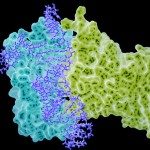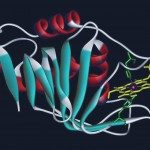Link to Pubmed [PMID] – 32747559
Link to DOI – 10.1073/pnas.2004138117
Proc Natl Acad Sci U S A 2020 08; 117(33): 19963-19969
Although more than 75% of the proteome is composed of multidomain proteins, current knowledge of protein folding is based primarily on studies of isolated domains. In this work, we describe the folding mechanism of a multidomain tandem construct comprising two distinct covalently bound PDZ domains belonging to a protein called Whirlin, a scaffolding protein of the hearing apparatus. In particular, via a synergy between NMR and kinetic experiments, we demonstrate the presence of a misfolded intermediate that competes with productive folding. In agreement with the view that tandem domain swapping is a potential source of transient misfolding, we demonstrate that such a kinetic trap retains native-like functional activity, as shown by the preserved ability to bind its physiological ligand. Thus, despite the general knowledge that protein misfolding is intimately associated with dysfunction and diseases, we provide a direct example of a functionally competent misfolded state. Remarkably, a bioinformatics analysis of the amino acidic sequence of Whirlin from different species suggests that the tendency to perform tandem domain swapping between PDZ1 and PDZ2 is highly conserved, as demonstrated by their unexpectedly high sequence identity. On the basis of these observations, we discuss on a possible physiological role of such misfolded intermediate.





